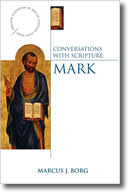The Gospel of Mark
An excerpt from the Conversations with Scripture series book on the earliest gospel
The following excerpt is taken from the Introduction, pages 3-12, and is used with permission from Morehouse Publishing.
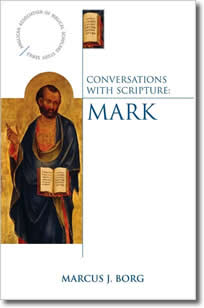 A CHRISTIAN PERSPECTIVE
A CHRISTIAN PERSPECTIVE
For me as a Christian, Jesus is the decisive revelation of God. This is Christianity’s most central claim and it goes back to its beginnings. In language from the New Testament, Jesus is “the image of the invisible God” (Col 1:15), “the Word of God” incarnate (John 1:1–14),“the Light of the World” (John 9:5), God’s revelation to Jews and Gentiles alike (Luke 2:32–33). Jesus reveals, discloses, embodies what can be seen of God in a human life.
This claim distinguishes Christianity from other religions. To use our two nearest relatives to illustrate this point, Jews find the decisive revelation of God in a book—in the Jewish Bible, especially the Torah (the first five books of the Bible, also known as the books of Moses, the Law, and the Pentateuch) and commentaries on it (the Mishnah and Talmud). So also Muslims find the decisive revelation of God in a book, the Quran. But Christians find the decisive revelation of God not in a book, but in a person: Jesus.
This distinction is not about superiority, but about difference. It has an immediate implication. Given Jesus’ centrality for Christians, it matters immensely how we see Jesus and the gospels that tell his story. If Jesus shows us what can be seen of God in a human life—well, what was he like?
A MAINSTREAM SCHOLARLY PERSPECTIVE
The second perspective that shapes the vantage point of this book is mainstream biblical scholarship. It is a way of seeing the Bible and the gospels that began in the Enlightenment of the seventeenth and eighteenth centuries and has continued to develop to this day.
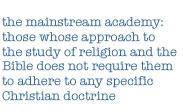 This perspective is shared by scholars within “the mainstream academy”— those whose approach to the study of religion and the Bible is taught in public and private universities and colleges where faculty are not required to adhere to specific Christian doctrines. This approach does not begin with a commitment to Christian beliefs, whether those beliefs are based on twenty-first-century American Christianity, or the sixteenth-century Reformation, or the fourth-century Nicene Creed. This perspective is shared by scholars whatever their religious orientation, and by those with no particular religious orientation at all.
This perspective is shared by scholars within “the mainstream academy”— those whose approach to the study of religion and the Bible is taught in public and private universities and colleges where faculty are not required to adhere to specific Christian doctrines. This approach does not begin with a commitment to Christian beliefs, whether those beliefs are based on twenty-first-century American Christianity, or the sixteenth-century Reformation, or the fourth-century Nicene Creed. This perspective is shared by scholars whatever their religious orientation, and by those with no particular religious orientation at all.
Some of you have encountered this kind of scholarship in university or college courses in religious studies. It is also the kind of biblical scholarship taught in most mainline Protestant and Catholic seminaries—at some institutions for more than a century; at others for only a generation or two. It is central to the theological foundation of what is increasingly called in our time “emerging” or “progressive”Christianity.
This way of seeing the Bible and the gospels is quite different from what many of us who grew up in the church learned early in life. Many of us formed the impression, whether explicitly taught or only implied, that the Bible is a divine product. Pronouncements that the Bible is “the Word of God” and “inspired by God” were understood to mean that the Bible comes from God in a way that no other book does. That is why the Bible matters: it has the authority of God and thus a divine guarantee to be true.
Within this framework, the Bible’s truth is most often understood to include both historical  factuality and moral absolutes. If the Bible says something happened, it happened; if the Bible says something is wrong, it’s wrong. Many of us also got the impression that the Bible should be interpreted literally, unless there are obvious reasons to do otherwise.
factuality and moral absolutes. If the Bible says something happened, it happened; if the Bible says something is wrong, it’s wrong. Many of us also got the impression that the Bible should be interpreted literally, unless there are obvious reasons to do otherwise.
Some Christians insist that this is the only Christian way of seeing the Bible—a test of Christian orthodoxy. Some have been able to retain this way of seeing the Bible into adulthood. Some have not, but think they should. And some have found another way of seeing the Bible shaped by mainstream biblical scholarship. Its foundations include:
■ The Bible is a human product, not a divine product. It is the product of two ancient communities. The Jewish Bible—what Christians call the Old Testament—is the product of ancient Israel. The New Testament is the product of the early Christian movement. To see the Bible as the work of human beings does not deny the reality of God, or the reality that the Bible was divinely inspired. But the Bible is not a divine product. Rather, it’s a collection of writings by our spiritual ancestors, the biblical ancestors of the Christian tradition. It tells us how they experienced the sacred, saw the world, told their stories, and understood what life with God involved.
■ The Bible is not to be interpreted literally, factually, and absolutely. Its language is often metaphorical, and its primary concern is not factual reporting. Its laws and ethical teaching are not absolutes relevant to all times and places, but are the products of those ancient communities and address their time and place. This does not mean that its laws and ethics are irrelevant to our time. But they cannot simply be directly transferred to the twenty-first century.
■ Seeing the Bible this way does not deny its status as Christian sacred Scripture. Instead, this viewpoint holds that Scripture is sacred not because of its origin, but because our spiritual ancestors canonized it—that is, declared it to be sacred. As sacred Scripture, the Bible is, along with Jesus, the foundation of Christian understanding and identity. It is also a way that the Spirit of God continues to speak to us today. Thus the Bible is sacred scripture in its status and function, but not in origin—not because it comes from God as no other book does.
From personal experience and the testimony of many, I am convinced that this way of seeing the Bible (including Mark and the other gospels) offers a way of re-claiming its power and meaning. It emphasizes understanding rather than belief, even as it also acknowledges limits of understanding. There is always more.
Mark within the Perspective of Mainstream Scholarship
In a sentence, Mark is seen by mainstream scholars as the product of developing early Christian traditions about Jesus and it combines memory, interpretation, and metaphor. We now unpack this sentence.
A DEVELOPING TRADITION
Seeing Mark (and the other gospels) as the product of a developing tradition means something very simple. As mentioned earlier, Mark is the earliest gospel, written around forty years after the historical life of Jesus. During those four decades, the traditions about Jesus developed. It is clear from the gospels themselves that the followers of Jesus understood him more fully after Easter than they did before Easter. Their conviction that God had raised Jesus and that he continued to be known affected their understanding of his significance decisively. They also adapted and applied the traditions about Jesus.
Here are three examples of the way the Christian tradition developed:
■ Peter’s declaration of Jesus’ identity in Mark 8:27–30, which we will look at in greater detail in Chapter 5. In this story, Jesus asks the disciples, “Who do you say that I am?” Peter answers, “You are the Messiah” (or “the Christ,” which means the same thing).
As Matthew takes this story over from Mark a few years later, he adds to it in two ways. To Peter’s affirmation that Jesus is the Messiah, Matthew 16:16 adds “the Son of the Living God.” In the next two verses, 16:17–19, Matthew adds that Jesus responds to Peter:
Blessed are you, Simon son of Jonah! [Peter’s name, before it became Peter]. For flesh and blood has not revealed this to you, but my Father in heaven. And I tell you, you are Peter [the name means “rock”], and on this rock I will build my church, and the gates of Hades shall not prevail against it. I will give you the keys of the kingdom of heaven, and whatever you bind on earth will be bound in heaven, and whatever you loose on earth will be loosed in heaven.
■ Jesus’ teaching about divorce and re-marriage. Mark 10:11–12 forbids re-marriage after divorce: “Whoever divorces his wife and marries another commits adultery against her; and if she divorces her husband and marries another, she commits adultery.” Matthew 19:9 changes Mark’s absolute statement by adding an exception clause: “Whoever divorces his wife, except for unchastity, and marries another commits adultery.”
■ Jesus’ entry into Jerusalem. In Mark 11:1–10, Jesus rides into the city on a colt. As Matthew incorporates this story into his gospel in 21:1–11, he adds another, so that Jesus rides into Jerusalem on two animals, a donkey and a colt (21:2, 3, 7). Matthew adds the second animal to make the story conform to his reading of a passage from Zechariah 9:9 in the Jewish Bible, which he quotes in 21:5.
There are multiple examples of such development as Matthew and Luke use Mark to write their own stories of Jesus. It is easiest to see this by using a book of “gospel parallels,” in which Matthew, Mark, and Luke are printed in parallel columns. The point: if development of the story of Jesus happened in the relatively short time between the writing of Mark and the writing of Matthew and Luke, then it is reasonable to assume that the story also developed before Mark was written.
As the product of a developing tradition, Mark and the other gospels contain the testimony of early Christians to the meaning and significance that Jesus had come to have in their lives in the decades since his historical life. And Mark and the other gospels also adapt and apply the traditions about Jesus to their communities in their time and place.
MEMORY AND INTERPRETATION
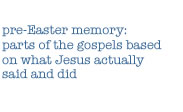 It’s clear that Mark and the other gospels combine earlier and later layers of material about Jesus. As the product of developing traditions, they contain pre-Easter memories of Jesus and post-Easter interpretation of what his life meant. “Pre-Easter memory” means that some of what is in the gospels goes back to things Jesus said and did. “Post-Easter interpretation” means that some of what is in the gospels is the way early Christian traditions testified to—and applied—what they understood about Jesus. Both matter—we do not need to choose between them. But it’s important and illuminating to see the difference.
It’s clear that Mark and the other gospels combine earlier and later layers of material about Jesus. As the product of developing traditions, they contain pre-Easter memories of Jesus and post-Easter interpretation of what his life meant. “Pre-Easter memory” means that some of what is in the gospels goes back to things Jesus said and did. “Post-Easter interpretation” means that some of what is in the gospels is the way early Christian traditions testified to—and applied—what they understood about Jesus. Both matter—we do not need to choose between them. But it’s important and illuminating to see the difference.
MEMORY AND METAPHOR
Mark also combines memory and metaphor, as do the other gospels— and biblical narratives generally. In its broad sense, the metaphorical meaning of language is its more than literal, more than factual, meaning.
I emphasize “more than” because of a common assumption in modern Western culture that metaphorical language is “less than” factual language. Many of us have heard people say when they hear that a biblical story might be metaphorical, “You mean it’s only metaphorical, only symbolic?” The question reflects the way our culture equated truth with factuality.
But metaphorical language is not inferior to factual language. Rather, metaphor is about meaning.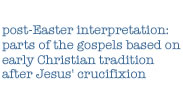 Metaphor is “the surplus of meaning” that language can carry, a phrase I owe to Paul Ricoeur, a twentieth-century scholar of religion. Metaphor and metaphorical narratives can be profoundly true—meaning-filled and meaningful, truthful and truth-filled. For example, the parables of Jesus are all metaphorical narratives; their purpose is not to report an event that actually happened. But nobody dismisses them because they're not as factual as newspaper articles. Everybody recognizes that the parables are about meaning, and the same is true with metaphorical narratives in general.
Metaphor is “the surplus of meaning” that language can carry, a phrase I owe to Paul Ricoeur, a twentieth-century scholar of religion. Metaphor and metaphorical narratives can be profoundly true—meaning-filled and meaningful, truthful and truth-filled. For example, the parables of Jesus are all metaphorical narratives; their purpose is not to report an event that actually happened. But nobody dismisses them because they're not as factual as newspaper articles. Everybody recognizes that the parables are about meaning, and the same is true with metaphorical narratives in general.
Some metaphorical narratives combine memory and metaphor. That is, they reflect an event that really happened, but the reason the stories were remembered and told is because they were seen to have a more-than-historical meaning.
For example, consider the story of Israel’s exodus from Egypt. Whatever historical memory lies behind that story, it was told not simply or primarily to report “what happened.” Rather, its more-than-factual, more-than- literal meanings mattered most to ancient Israel, as they do for us. The story of Israel’s flight from Egypt is a story of bondage to Pharaoh, liberation by God, journey through the wilderness, and arrival in “the promised land.”
The story was—and continues to be—a metaphorical narrative of the human condition and the path of deliverance. It portrays the human condition with an image of bondage: we are not free, the story tells us, but enslaved by the Pharaohs who rule our lives. God’s will is that we be liberated into a life under God rather than under the lords of this world. Together, bondage and liberation are powerful biblical metaphors for the human predicament—and its solution.
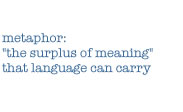 We turn to a second example of a biblical story that combines memory and metaphor. The Jewish experience of exile in Babylon happened in the 500s BCE. After half a century in exile, some Jews returned to their homeland. That is memory. But the language of exile and return is about more than memory. Like bondage, exile is a central biblical image for a larger experience—the sense of separation and estrangement that often marks our lives. When our problem is exile, this Bible story tells us, the solution is a journey of return.
We turn to a second example of a biblical story that combines memory and metaphor. The Jewish experience of exile in Babylon happened in the 500s BCE. After half a century in exile, some Jews returned to their homeland. That is memory. But the language of exile and return is about more than memory. Like bondage, exile is a central biblical image for a larger experience—the sense of separation and estrangement that often marks our lives. When our problem is exile, this Bible story tells us, the solution is a journey of return.
Our third example of memory and metaphor comes from Mark: the story of Jesus’ final journey to Jerusalem (8:22–10:52). Jesus really made that journey. But Mark overlays the story with a metaphorical meaning: our own journey of discipleship means following Jesus— on the way that leads to Jerusalem, death, and resurrection.
There is a second kind of metaphorical narrative in the Bible—those stories that are purely metaphorical, without elements of memory. A classic example is the Genesis story of Adam and Eve. Mainstream scholars do not think there ever was an Adam or Eve, a Garden of Eden, a tree of the knowledge of good and evil, or a talking serpent. And yet as a metaphorical narrative, the story of Adam and Eve is filled with meanings and truths. To echo Thomas Mann, it is a story about the way things never were, but always are. Like most metaphorical narratives, it has more than one meaning. Among its meanings: we begin our lives “in God,” in paradise, but we live our lives “east of Eden,” that is, outside of the felt presence of God, and we yearn to return.
The meaning and truth of metaphorical narratives are not dependent on their literal or historical factuality. They need not be based on the memory of something that happened.
To provide an illustration from Mark: the gospel has two stories of Jesus stilling a storm on the Sea of Galilee, and in one he also walks on the water (4:35–41, 6:45–52). For more than one reason, mainstream scholars do not think these stories are based on the memory of something that happened. They are purely metaphorical narratives. I will treat them in detail in Chapters 3 and 4, but for now I emphasize that a metaphorical approach does not focus on the factual question of whether Jesus really did still a storm and walk on water. Instead, it focuses on the more-than-factual meanings of these stories—on their meanings as metaphor.
Interpreting Mark: A Historical-Metaphorical Approach
How we interpret a biblical text matters greatly. To say anything at all about a text is to interpret it. This is true for everybody, including those who read biblical texts literally, factually, and absolutely. The Bible does not come with footnotes that tell us to interpret a text this way. Rather, doing so involves an interpretive decision, whether consciously or unconsciously made, to interpret the Bible literally, factually, and absolutely.
From mainstream scholarship’s way of seeing Mark (and the Bible as a whole) flows a different way of interpreting the traditions that Mark put together in his gospel. In shorthand, this way of interpreting Mark involves a “historical-metaphorical approach.”
In the nineteenth century, this was commonly called “the higher criticism” and in the twentieth century “the historical-critical method.” The words “criticism” and “critical” distinguished this approach from pre-critical or non-critical ways of seeing the Bible. But calling it a “historical-metaphorical” approach better expresses the fullness and richness of this way of seeing the Bible.
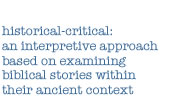 A historical approach means, very simply, setting biblical texts in their ancient historical contexts. To avoid a possible misunderstanding, let’s be clear about what we don’t mean by “historical.” Sometimes, the word “historical” is used to refer to an event that happened, as when we ask if a story about our grandparents is true. “Is that historical?” we might ask our amateur family historian. “Did it really happen that way?” But that’s not what we mean by a historical approach to the Bible and to the gospel of Mark. A historical approach is not intrinsically concerned with the question of factuality. Though it can address that question, it is seldom crucially important.
A historical approach means, very simply, setting biblical texts in their ancient historical contexts. To avoid a possible misunderstanding, let’s be clear about what we don’t mean by “historical.” Sometimes, the word “historical” is used to refer to an event that happened, as when we ask if a story about our grandparents is true. “Is that historical?” we might ask our amateur family historian. “Did it really happen that way?” But that’s not what we mean by a historical approach to the Bible and to the gospel of Mark. A historical approach is not intrinsically concerned with the question of factuality. Though it can address that question, it is seldom crucially important.
Rather, the historical approach to the Bible means setting a text—whether a narrative, a hymn or prayer, poetry or parable, legal or ethical teaching— in the historical context of the life of the ancient community in which it originated. Doing so has great illuminating power.
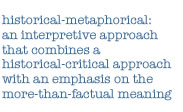 Importantly, historical context is not simply “background” or “setting.” It’s interactive—time and place are not simply the background and setting in which we live, but they shape what we say and do.
Importantly, historical context is not simply “background” or “setting.” It’s interactive—time and place are not simply the background and setting in which we live, but they shape what we say and do.
For example, the American Civil War was not simply the “background” or the “setting” of Abraham Lincoln’s presidential addresses; it was their interactive context. He would not have said what he said, or said it in the way that he did, apart from the interactive context of the Civil War. So also, a century later, American racism and the civil rights movement were not simply the “background” or “setting” of Martin Luther King’s memorable speeches and sermons—it was their interactive context. It shaped him and what he said.
We turn to how this affects our reading of Mark. A historical approach sets Mark’s story of Jesus in the historical context in which this gospel was written around the year 70 C.E. What was going on in Mark’s community and within the larger world of Judaism and the even larger world of the Roman Empire? What did the stories and teachings in Mark mean within those contexts?
This emphasis on the ancient meanings of biblical and gospel texts does not mean confining or reducing them to those ancient meanings. But it does mean that thinking about their meanings for us in our contemporary context begins with thinking about their ancient meanings. What does what they meant then suggest about their meanings for our now?
We’ve already looked at the foundations of a metaphorical approach. Using this approach helps us focus on the more-than-literal meaning of biblical and gospel narratives, developing a sensitivity to the meanings of a story. And the metaphorical approach is enhanced by the historical approach. That is, given what we know about the historical context, what more-than-factual, more-than-literal meanings do we see in this story?
Within this framework, we now turn to Mark. We focus on what we can know or surmise with reasonable probability about the authorship and interactive context of the earliest gospel.
From The Gospel of Mark by Marcus Borg. Copyright ©2009 by Marcus Borg. Used with permission from Morehouse Publishing, an imprint of Church Publishing Inc.
Help explorefaith when you purchase CONVERSATIONS WITH SCRIPTURE: THE GOSPEL OF MARK or any other item from Church Publishing, Inc., our Partner in Ministry.
Also available from amazon.com.

